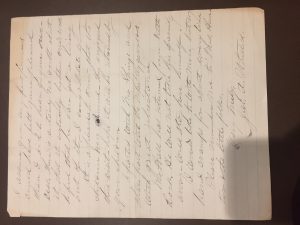The archival materials I examined in class and on the Digital Durham website revealed a lot about daily life in Durham and issues relevant to people back then.
The Orange County tax list from 1875 sheds light on what was considered valuable. The headers include the numbers of animals and land acreage people owned. Landowners like Washington Duke had more land, more animals, and thus, more wealth. It was also very interesting to see names I recognized, like Washington Duke, in the tax list. For me, I don’t know much about Durham history, so being able to learn more about Durham’s key historical figures was fascinating.
I think the tax list also highlights the importance farming still had in the new South. Many people, both blacks and whites, were farmers. As Ayers explained, after the Civil War, angry farmers formed alliances or groups to champion more representation for farmers. And the tax list demonstrates that owning animals and planting crops were activities important to making a living.
Furthermore, I also discovered a lot from some of the archival materials I noticed on the Digital Durham website.
For instance, I looked at Emerson’s North Carolina tobacco belt directory in 1886 which lists businesses within the corporate limits of Durham. Also listed in the directory are the names of proprietors, stores’ locations, and the products sold. Businesses owned by people of African American heritage are denoted with an asterisk. Such a document could help someone research the industrialization and urbanization of Durham–an emblem of the New South. The directory provides glimpses into life in 1886. Many of the names in the directory sold tobacco, and even ads, such as the cigar ad on page 6 or the multiple page spread starting on page 27 of Allison & Addison’s Star Brand Tobacco, illustrates the growing prevalence of Durham tobacco. The thriving tobacco industry would soon lead to rapid increases in population and business in Durham.
In this time period, relations between blacks and whites were strenuous, and many black weren’t afforded fair rights, but some had more opportunities and were able to receive educations and distinguish themselves. Although many were relegated to becoming sharecroppers, there still existed more opportunities for African Americans–as some of the directory entries show. Some owned grocery stores, others barber shops, and still others ventured into tobacco.
Other maps on the site underline the prevalence of railroads in Durham. Railroads were a technological innovation that helped increase urban growth; however, they were also sites of tense racial clashes. Because railroads contained the same facilities, whites and blacks sometimes get entangled in violence. Some railroads created separate cars, one for blacks and one for whites–a pricey and unprofitable endeavor. Other trains used two different classes, and sometimes, forced African Americans to use second-class facilities even when they’d paid for first class.
The archival materials can help provide more context and explain some of the issues Ayers discussed.



